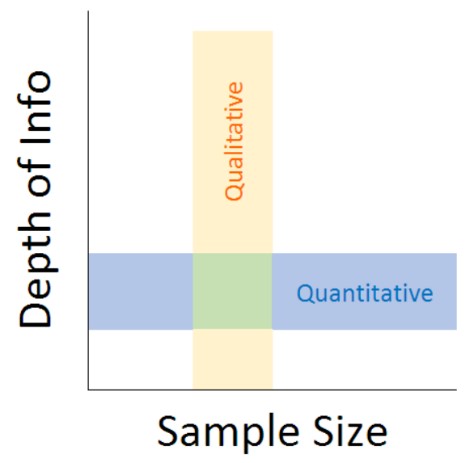How to choose the best method for your research study
Quantitative and qualitative research are both scientific methods for data collection and analysis. They can be applied alone, or in combination, to maximize insights.
The Basic Difference: Going Beyond What vs. Why
QUANTITATIVE RESEARCH, AKA QUANT
Quantitative research relies on large sample sizes to collect numerical data that can be mathematically analyzed for statistically significantfindings. Surveys are structured, questions are typically closed-ended, and answer choices are fixed. However, quantitative research may also include a limited number of short-answer open-ended questions to help clarify why people responded the way they did to a closed-ended question. Eye tracking, facial coding, and even Big Data fall under the umbrella of quantitative research, with computers analyzing enormous volumes of data incredibly fast.
Quantitative studies produce numerical data, which allows for statistical analysis and ultimately precise findings. The US Census is a great example of a quantitative research study – fixed and close-ended questions, an enormous sample size, a collective review of many respondents, and measured population segments.
QUALITATIVE RESEARCH, AKA QUAL
In contrast, qualitative research seeks to understand the reasons behind the numbers, as well as what is not yet known. Sample sizes are smaller, questions are unstructured, and results more subjective. Unlike quantitative research, qualitative studies insert the researcher into the data collection process. The researcher probes responses and participants provide more detail. Qualitative data is collected through interviews, group discussions, diaries, personal observations, and a variety of other creative and ever-expanding means.
Qual studies work with textual and visual data, interpreted and analyzed for directional findings. Qualitative research studies include fluid and open-ended questions, a smaller sample size, an in-depth review of each respondent, and emerging themes.

A quant study collects specific data from a large number of people, and a qual study goes deeper to collect greater insights from a small number of people.
How to Choose
The answer to whether you proceed with quantitative or qualitative research lies in your research objective and available resources.
- Why you’re doing the research
- What you need to know
- Your budget, staff, + schedule
- How the findings will be used
Consider these possible scenarios the next time you’re stuck and don’t know which way to go:
Quant + qual can come together in other ways. A questionnaire with open-ended questions, while ultimately coded numerically, can offer a window into the unknown. Focus groups that also include poll questions or surveys can produce hard data when analyzed in total, even if the results are not statistically significant.
With good planning, quantitative and qualitative research come together like a dance, guiding the marketer’s success with every step.
I Say Hybrid, You Say Multi-Method
Combining quantitative and qualitative research approaches is an ancient strategy, but the names continue to change with the times. I did a bit of research and found the following terms being used to describe that ideal combination of quantitative and qualitative research. What term do you use? And why? 😉


 Quantitative studies require a
Quantitative studies require a 




